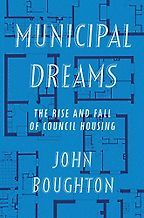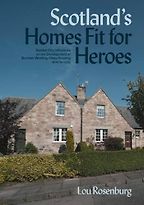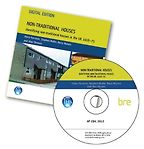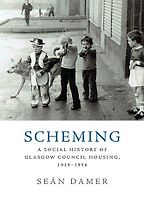Before we talk about the books, how do you define social housing?
Social housing is a broad term which covers housing provided not in order to make money. Traditionally, in the UK it’s mainly been council housing—that is, housing provided by local authorities—but the term also includes housing provided by housing associations, which are semi-public bodies which exist to meet social need rather than to make money for shareholders. With the hundred-year anniversary of the UK’s Housing Act 1919, social housing is once again at the forefront of policy discussions about architecture, urban planning and the built environment in the UK.
In terms of my own interests: the work I did for many years centred on early 20th-century housing—my first book Homes Fit for Heroes focused on the 1919 Housing Act and what lay behind it. My latest book, Cook’s Camden, looked at a much more recent period, the 1960s and 70s. The two themes come together because of the current recognition of the need for council housing. The image that people per often associate with ideal council housing is Neave Brown’s Alexandra Road scheme in Camden, which I cover in my book.
That’s the archetype of the ideal social housing project, though the history of social housing in Britain has been far more chequered than this estate project would suggest. Tell us a little about the history of social housing in the UK.
The 1919 Housing Act transformed council housing from being something that a few local authorities did if they felt like it, to being something that every local authority was required by the government to do and for which a Treasury grant—that is money from the central government—was made available to finance it. The government promised to build ‘homes fit for heroes’—the troops returning from the trenches—and the 1919 Act was their way to achieve it. Because of that you get a you get council housing becoming a major part of the housing system in the UK from that moment onwards.
Get the weekly Five Books newsletter
Up until the First World War, council housing was a maximum 2% of new housing that was being built per annum. In the three years from 1919 it was 60%. For the interwar period as a whole it was 30% and for the period from the early 1950s through to the seventies it was almost 50%. percent. So 1919 is the point at which we can say council housing becomes a major part of the way in which we provide housing in the UK.
The third period that you describe, the post-war period up to the 1970s, is probably still regarded historically as the apotheosis of social housing or council housing in Britain, with it tailing off quite significantly from around 1980 with the introduction of right-to-buy. That’s a major watershed historically.
From the late 1940s through the 1970s we had what has been called the ‘Golden Age’ of the welfare state in Britain, and indeed across Europe as a whole. Housing was a major part of that. Local authorities were building on an enormous scale. This was to address the massive shortage resulting from damage to the housing stock from the second world war. It was agreed across the political spectrum that council housing was needed to address this shortage and in fact Labour and Conservatives competed to be the party that was providing the most, in what was called ‘the numbers game’. That remained the case through until the economic crisis of the 1970s when the Labour government cut back on council housing and the number of council housing starts started to go down quite significantly. But they did so with reluctance.
“Once the tenant owned the home, they could then sell it on. So those homes moved from the public to the private sector . . . Which in large part helps to explain why we have a housing crisis today.”
The change came in 1979. When Margaret Thatcher was elected in 1979 she cut back on council housing as a matter of policy, because she wanted to re-establish the dominance of the market. She cut back on new local authority housing as much as she could and at the same time she introduced the ‘right to buy’, which gave tenants the right to buy their council homes at a very advantageous price. As a result of that you had far less local authority housing being built and a lot of what had been built being transferred to the private sector in the person of the tenant. Once the tenant owned the home, they could then sell it on. So those homes moved from the public to the private sector.
Which in large part helps to explain why we have a housing crisis today. That reliance on the market remained government policy from Margaret Thatcher right through the Blair-Brown years and into the David Cameron era. We’ve had 40 years of looking to the market to solve the housing problem. The private sector is fine providing housing for people who can pay the market price for it, but it’s no good at providing housing for people to can’t—and with housing we have a market where prices have continued to rise almost without interruption in those 40 years.
You see this acutely in parts of the country where property is the focus of speculative investment. London is a prime example. You’ve got a situation where terrific amounts of homes are unoccupied while at the same time there is a shortage of housing for people providing essential services to the local population.
That’s why in the last three or four years there’s been a quite a significant shift. We may now all be preoccupied in the UK with Brexit and the general election but under the previous government led by Theresa May there was a real change in policy. Theresa May recognised that the housing market was broken and that you couldn’t just look to the private sector. So in November of 2018 she removed the borrowing cap on local authorities, allowing them to borrow money against their assets to build council housing. In fact, the Department of Housing and Local Government was very energetic during the last months of the May government geeing up local authorities to build. The result is that we have local authorities building again, especially in London—not as they were in the 70s, but at a much greater pace than in the 90’s and noughties. The reason is because of the housing crisis. Many people just can’t afford to buy homes or even rent homes, and it’s not just the poor or the working class, it’s the middle class as well—civil servants, surveyors, lawyers, lecturers and the like.
There does seem to be an incipient revival of councils in building homes. Our conversation coincides with the award by the Royal Institute of British Architects this year of the RIBA Stirling prize to a council design in Norwich. There seems to be a reappraisal in the public eye as well as professional circles of social housing or council housing which perhaps ties in with the recent reappraisal of the sort of designs that informed Cook’s Camden—highly functional modernist design which is very humane. It’s an aesthetic that has become very fashionable in recent years, but that seems to reflect more than just a passing fad. There appears to be growing public awareness around questions of social equity and sustainability that these designs tried to answer.
This is the first time ever that the RIBA Stirling prize has been awarded to a project that is purely council housing. There was the Accordia housing scheme in Cambridge, which won in 2008, but this is the first time a purely council scheme has won the Stirling prize. Moreover, the project, Goldsmith Street in Norwich, also won the new Neave Brown housing award, which RIBA set up this year in memory of Neave Brown, the most important architect from the Camden era from the 60s and 70s. Brown’s Alexandra Road housing is widely regarded as the emblematic council housing scheme—built by a local authority, designed by a very brilliant and very socially committed architect and highly regarded by the people that live there. People from all over the world visit to admire the aesthetics and design, but more importantly the people who live there really appreciate it and enjoy living there. The re-evaluation of the Camden work, which my book contributed to, has fed into this sense that we need to look again at council housing. It doesn’t just mean sink estates or inhospitable tower blocks. It means providing good housing for regular people. It’s not a ghetto. It’s a place where ordinary people—teachers, firemen, nurses, tradesmen—all varieties of people can make successful homes.
Social housing is often caricatured as being associated with slum clearance or with crime-ridden Estates. Brutalist architecture is often roped into the caricature as a dehumanising environment in which to live and work. Municipal Dreams tries to recover a more idealistic view that prevailed not long ago. This social housing book seems to provide an antidote to some of the caricature and also some of the extreme market-driven solutions that have led to the housing crisis as you described.
John Boughton’s book is a really welcome publication. For a long time he’s been producing a blog called ‘Municipal Dreams’. It is a fantastic resource. He beetles around the country and researches dozens and dozens of local authority housing schemes. It’s that very detailed knowledge on the ground that feeds into his book.
The book is an overview of the story of council housing over the last hundred and twenty years. But as the story progresses, the focus gets closer and closer. We get to the second world war, half way through the story, in about 50 pages, but then the next 250 pages are on the period since then, and particularly the last 30 years. What is so good about it is that he sets these quite recent developments into this continuous historical narrative. It’s very difficult for people operating in the world we live in today to have a historical perspective on what’s happening—you’re dependent on newspapers and those kind of accounts that don’t contextualise the subject at all. Boughton’s book brings the historical perspective right up to the present day.
“He beetles around the country and researches dozens and dozens of local authority housing schemes.”
The extraordinary things that were going on under New Labour governments of Tony Blair and Gordon Brown, for example, which actually built far less council housing than Margaret Thatcher had, are here brought out clearly. It’s therefore very enlightening to people who are trying to get just trying to get their heads around what’s going on in the housing situation that we have today.
I like the fact that it’s not a partisan book. It’s informed by his very clear affection for some of the more idealistic schemes over the years. As you say it points out the flaws and perhaps also some of the wins of initiatives undertaken by either side of the political divide. Social housing was used for highly partisan purposes at various times in the last century. It’s encouraging if this question is becoming less partisan than it had been previously.
At times the debate around social housing was highly partisan, but equally at other times there was consensus. The Tories in the 50s built far more housing than Labour had done. It’s really to do with changing political perspectives. A decade ago to be arguing for council housing would have been regarded as a very left-wing position to take. Today, because of the undoubted failure of housing policy over the past decades to meet the housing shortage, it’s fairly widely agreed that if you’re going to tackle the housing shortage local authorities are the only institutions that have got the muscle to do so.
Boughton writes with passion. He’s a great advocate of council housing, but he’s by no means uncritical. He can see where some things have been successful and other things not so successful. Also, he’s not he’s not saying everything that architects did was great, nor that everything architects did was terrible. He’s a social historian who takes a sensible and sober view of the whole thing.
Two of the books that you chose—Sean Damer’s and Lou Rosenberg’s—focus on Scotland to a great degree. Scotland is an interesting case study for having some of the exemplary tenement and council estates but also for some of the more disastrous developments, and Sean Damer eloquently describes in Scheming.
Scotland is a very interesting part of the whole story and in some ways is distinct from the rest of the UK. The five books I’ve chosen come from distinctive academic disciplines and distinctive sensibilities. Boughton is a historian. The Scheming book is written by a sociologist. Sean Damer’s interest, first and foremost, is in what was it like to be a family living in a slum which then got relocated to one of these new Glasgow Corporation housing schemes. That’s where the name of the book, Scheming comes from. In Scotland council housing projects are generally called housing schemes and, in a derogatory way, people who live on them are referred to as ‘schemies’. Damer’s research, carried out around 1990, involved interviewing people who had moved into these council schemes in the 1920s, 30s, 40s and 50s and who were still living there. Those interviews are the meat of the book. It’s just fantastic to read about the experience that people had of relocating to these places and how they found them such an upgrade, their excitement at the facilities which they never had before such as bathrooms and running water and other facilities that today we take for granted.
“It’s often the voice of the tenants that gets left out of architectural history.”
The chapter on the Mosspark garden suburb—the scheme built by Glasgow Corporation under the 1919 Housing Act—is particularly revealing. What he shows was that although these may have been heroes, veterans from the war, that were living there they weren’t mere ‘squaddies’. These were heroes from the officer class, because these were highly sought-after homes. The rents were very high. There was pretty clear social exclusion operating even under this scheme. If you came from a rough neighbourhood originally, you wouldn’t be considered for tenancy. The Bowling Club was the centrepiece of social life on the estate and was full of businessmen, solicitors, surveyors—professional people in other words. That really brings it home that these stereotypes about council housing through the ages are not a true reflection of the historic reality. Here was a project that was basically housing middle-class people, because these were the best homes that you could get in Glasgow at that time.
As an aside, I’m reminded of the work of political scientist Robert Putnam. He wrote a book called Bowling Alone in which he talks about the fracturing of civil society in the US as a function of the decline in social gatherings like bowling or the Rotary Club and the like. These first-hand accounts really helped to highlight the importance of community and the ability of a design to either promote or inhibit community.
It’s true—it’s often the voice of the tenants that gets left out of architectural history. Studies on the history of housing tend to be based on archival sources, on plans, blueprints and other architectural material. The voices of the people who lived there is absolutely captured by Sean Damer and is a really crucial element.
Like me, Damer started working on housing in the 1970s. At the time there was a huge flowering of research into housing. It was a very contested area. In the social and economic crisis that the country was going through, housing was seen as a crucial element of the relationship between labour and capital. On top of that, under the 50-year rule the government papers, which had remained closed until then, became available. In my book, I was able to use all the ‘secret papers’ of government to really uncover what had motivated the government to introduce the 1919 Housing Act. But my work covered England and Wales—Scotland had its own story as I mentioned.
I chose Lou Rosenberg’s book because it redresses that, looking specifically at Scotland. And again, it does so from a different point of view. He comes at the subject from a conservation angle. Rosenberg went around and looked at loads of projects across Scotland.
“The aspiration after the First World War was to produce something that was fit for the heroes coming home.”
His insights are based not on primary research involving documents in archives but more on getting out and seeing first-hand what was built. The result is a very revealing account of the contribution that council housing has made to Scottish towns and cities and even the countryside. We had in the region of 200,000 homes built by councils in Scotland between the wars and they include some of the best housing that exists even now—because the aspiration after the First World War was to produce something that was fit for the heroes coming home. It’s really powerful. Big houses, high building standards, bathrooms, indoor toilets and other creature comforts for their day.
And Scotland was also one of the most enthusiastic emulators in developing the idea of the Garden City?
The garden city was an idea that was really developed in England. It originated with Ebenezer Howard, who came up with the idea in 1898, and it was then taken up and developed by Raymond Unwin, the architect and planner who designed the first garden city, at Letchworth. It then shifted towards the garden suburb. Hampstead Garden Suburb is the most famous, designed by Unwin who himself then moved into government—he designed a great deal of housing for munition workers during the First World War and then was chief architect for the housing program under the 1919 Housing Act. So essentially what local authorities were building under the 1919 Act is a municipal version of pre-war garden suburbs, and that’s the case in Scotland as much as elsewhere.
Stephen Merrett’s social housing book State Housing in Britain is not one I managed to get my hands on. Why did it make your list?
It’s no longer in print, I’m afraid, but well worth seeking out if you are looking into this subject. This was another product of that great explosion of interest in social housing during the 1970s. Stephen Merrett is an economist, so he comes to the subject from that point of view, giving a very succinct account of the political economy of local authority housing in the UK. This makes it an incredibly useful book—the facts and figures that he produces in the book are invaluable. The economics are a driving force of many of the changes we are discussing. For anybody who wants to know about the subject in the period from the early 20th century through to the 1970s, this is an essential reference manual.
Finally, let’s talk about Non-Traditional Houses, edited by Harry Harrison amongst others. A lot of the more famous social housing schemes that we’ve mentioned in the books so far—and there are many more examples—were ‘non-traditional’ in some way, right up to the current day. The Norwich Council development which won the Stirling prize is a highly innovative project for being extremely energy efficient, but also for the way that it deals with the delineation between public and private space.
That’s true. The Norwich scheme is built to the Passivhaus standard, a very demanding standard that drastically reduces energy use by making the envelope of the building entirely airtight. But in the organisation of public and private space it is clearly indebted to Neave Brown. A gate at the end of the garden leads to a communal garden, which is a textbook case of a semi-private space. No one can get into it unless they have one of those gardens. So innovation of all kinds has been a continuing theme in the history of council housing and innovation in construction was part of the story right from the start.
This book, Non-Traditional Houses, is part of that story. It is published by the Building Research Establishment (BRE), the successor to the Building Research Station, which was founded in 1919, because Raymond Unwin told the government that in order to build all these houses at a time of great scarcity, we’re going to have to use materials that have not been used before: alternatives to bricks for walls, alternatives to timber for floors, alternatives to plaster as there was a shortage of plasterers. So it was a matter of expediency. However, there was also the sense that if housing was really going to get sorted out we would have to bring to bear on it the latest most advanced scientific thinking. We would have to apply science to house building, which at that time was still a craft-based business. Then in the mid-1920s Neville Chamberlain, the Conservative politician, decided that if we were to build council housing we would have to undertake very significant research into building methods and so he pumped a huge amount of money into the Building Research Station to undertake this work.
“As a council, if you own say 500 of these houses and they’re deteriorating, you need to know exactly what, and where, the cause of the problem is!”
The Non-Traditional Houses book is an archetypal product of the Building Research Station, looking at the hundreds of new systems that were developed in response to this demand. Some of the systems were not successful at all—buildings that started deteriorating pretty fast. But others have lasted well. This book is an encyclopaedia of the housing systems that were used. When you look at a building from the outside, it may not be clear what they are made of: if the walls are rendered you can’t tell if it is built of concrete blocks, or timber, or what. As a council, if you own say 500 of these houses and they’re deteriorating, you need to know exactly what, and where, the cause of the problem is! All the different systems, materials and methods are explained in this encyclopaedic volume. Having identified any defects, you can work that back to the construction of the houses and act accordingly. There’s a CD that goes with the book, and this may be more easily found these days than the book itself. It’s a completely different take on the subject from that of a historian or economist. But if we’re going to understand social housing and build again in earnest—and the sense of crisis at the moment makes it increasingly likely that we’re going to have to involve local authorities—this kind of technical knowledge is essential.
Might we be entering a new golden age of social housing?
If there is a new era starting it’s going to involve local authorities. In the 1980s and 90s what were called ‘private-public partnerships’ were the mantra of the 80s and 90s but there has been a reaction against them as ultimately many such partnerships have saddled the public purse with huge debts. I think it’s more likely that local authorities themselves start to build on their own terms. That’s what we see happening with a good number of local authorities in London, for example, now building housing once again. That’s why we need to learn from the experience of the past hundred years.
Indeed. And from cautionary tales like the tragedy of Grenfell Tower, which we can all hope marks a watershed towards something more idealistic and more humane in the build environment.
Absolutely. The Grenfell tragedy was a real wake-up call, the most appalling reminder of what happens if you neglect social housing. At the most basic level, it shows the need for proper systems of building control.
If you can clad an apartment block with flammable cladding, what’s happened to the codes? After the Great Fire of London in 1666, building codes were introducing that forbade flammable materials on the outside of buildings, and yet here we are some 400 years later doing just that! The books I’ve selected I hope provide a remedy for that kind of blinkered view.
Interview by Romas Viesulas
January 3, 2020. Updated: December 12, 2020
Five Books aims to keep its book recommendations and interviews up to date. If you are the interviewee and would like to update your choice of books (or even just what you say about them) please email us at [email protected]
Five Books interviews are expensive to produce. If you've enjoyed this interview, please support us by donating a small amount.












